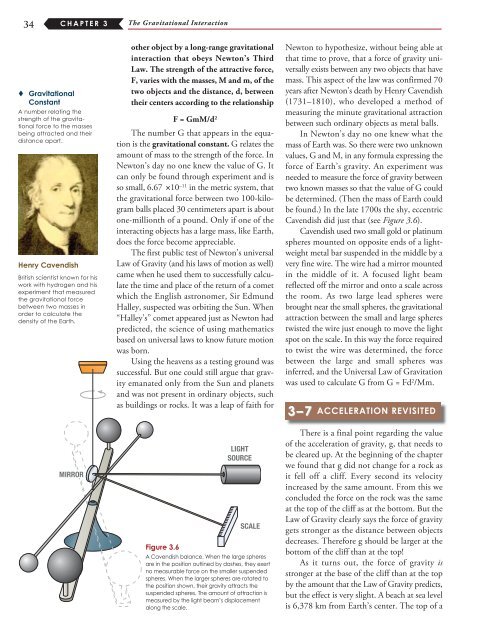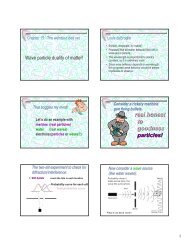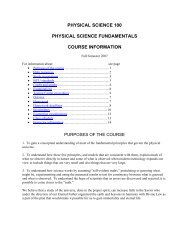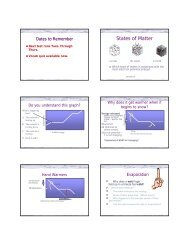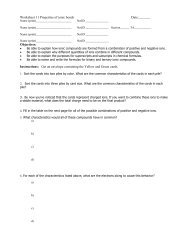knowledge, science, and the universe chapter 1 - Physical Science ...
knowledge, science, and the universe chapter 1 - Physical Science ...
knowledge, science, and the universe chapter 1 - Physical Science ...
You also want an ePaper? Increase the reach of your titles
YUMPU automatically turns print PDFs into web optimized ePapers that Google loves.
34<br />
C h A p T E R 3<br />
The Gravitational Interaction<br />
Gravitational<br />
Constant<br />
A number relating <strong>the</strong><br />
strength of <strong>the</strong> gravitational<br />
force to <strong>the</strong> masses<br />
being attracted <strong>and</strong> <strong>the</strong>ir<br />
distance apart.<br />
henry Cavendish<br />
British scientist known for his<br />
work with hydrogen <strong>and</strong> his<br />
experiment that measured<br />
<strong>the</strong> gravitational force<br />
between two masses in<br />
order to calculate <strong>the</strong><br />
density of <strong>the</strong> Earth.<br />
MIRROR<br />
o<strong>the</strong>r object by a long- range gravitational<br />
interaction that obeys Newton’s Third<br />
Law. The strength of <strong>the</strong> attractive force,<br />
F, varies with <strong>the</strong> masses, M <strong>and</strong> m, of <strong>the</strong><br />
two objects <strong>and</strong> <strong>the</strong> distance, d, between<br />
<strong>the</strong>ir centers according to <strong>the</strong> relationship<br />
F = GmM/d 2<br />
The number G that appears in <strong>the</strong> equation<br />
is <strong>the</strong> gravitational constant. G relates <strong>the</strong><br />
amount of mass to <strong>the</strong> strength of <strong>the</strong> force. In<br />
Newton’s day no one knew <strong>the</strong> value of G. It<br />
can only be found through experiment <strong>and</strong> is<br />
so small, 6.67 ¥10 –11 in <strong>the</strong> metric system, that<br />
<strong>the</strong> gravitational force between two 100-kilogram<br />
balls placed 30 centimeters apart is about<br />
one-millionth of a pound. Only if one of <strong>the</strong><br />
interacting objects has a large mass, like Earth,<br />
does <strong>the</strong> force become appreciable.<br />
The first public test of Newton’s universal<br />
Law of Gravity (<strong>and</strong> his laws of motion as well)<br />
came when he used <strong>the</strong>m to successfully calculate<br />
<strong>the</strong> time <strong>and</strong> place of <strong>the</strong> return of a comet<br />
which <strong>the</strong> English astronomer, Sir Edmund<br />
Halley, suspected was orbiting <strong>the</strong> Sun. When<br />
“Halley’s” comet appeared just as Newton had<br />
predicted, <strong>the</strong> <strong>science</strong> of using ma<strong>the</strong>matics<br />
based on universal laws to know future motion<br />
was born.<br />
Using <strong>the</strong> heavens as a testing ground was<br />
successful. But one could still argue that gravity<br />
emanated only from <strong>the</strong> Sun <strong>and</strong> planets<br />
<strong>and</strong> was not present in ordinary objects, such<br />
as buildings or rocks. It was a leap of faith for<br />
LIGHT<br />
SOURCE<br />
SCALE<br />
figure 3.6<br />
A Cavendish balance. When <strong>the</strong> large spheres<br />
are in <strong>the</strong> position outlined by dashes, <strong>the</strong>y exert<br />
no measurable force on <strong>the</strong> smaller suspended<br />
spheres. When <strong>the</strong> larger spheres are rotated to<br />
<strong>the</strong> position shown, <strong>the</strong>ir gravity attracts <strong>the</strong><br />
suspended spheres. The amount of attraction is<br />
measured by <strong>the</strong> light beam’s displacement<br />
along <strong>the</strong> scale.<br />
Newton to hypo<strong>the</strong>size, without being able at<br />
that time to prove, that a force of gravity universally<br />
exists between any two objects that have<br />
mass. This aspect of <strong>the</strong> law was confirmed 70<br />
years after Newton’s death by Henry Cavendish<br />
(1731–1810), who developed a method of<br />
measuring <strong>the</strong> minute gravitational attraction<br />
between such ordinary objects as metal balls.<br />
In Newton’s day no one knew what <strong>the</strong><br />
mass of Earth was. So <strong>the</strong>re were two unknown<br />
values, G <strong>and</strong> M, in any formula expressing <strong>the</strong><br />
force of Earth’s gravity. An experiment was<br />
needed to measure <strong>the</strong> force of gravity between<br />
two known masses so that <strong>the</strong> value of G could<br />
be determined. (Then <strong>the</strong> mass of Earth could<br />
be found.) In <strong>the</strong> late 1700s <strong>the</strong> shy, eccentric<br />
Cavendish did just that (see Figure 3.6).<br />
Cavendish used two small gold or platinum<br />
spheres mounted on opposite ends of a lightweight<br />
metal bar suspended in <strong>the</strong> middle by a<br />
very fine wire. The wire had a mirror mounted<br />
in <strong>the</strong> middle of it. A focused light beam<br />
reflected off <strong>the</strong> mirror <strong>and</strong> onto a scale across<br />
<strong>the</strong> room. As two large lead spheres were<br />
brought near <strong>the</strong> small spheres, <strong>the</strong> gravitational<br />
attraction between <strong>the</strong> small <strong>and</strong> large spheres<br />
twisted <strong>the</strong> wire just enough to move <strong>the</strong> light<br />
spot on <strong>the</strong> scale. In this way <strong>the</strong> force required<br />
to twist <strong>the</strong> wire was determined, <strong>the</strong> force<br />
between <strong>the</strong> large <strong>and</strong> small spheres was<br />
inferred, <strong>and</strong> <strong>the</strong> Universal Law of Gravitation<br />
was used to calculate G from G = Fd 2 /Mm.<br />
3–7 ACCELERATION REVISITEd<br />
There is a final point regarding <strong>the</strong> value<br />
of <strong>the</strong> acceleration of gravity, g, that needs to<br />
be cleared up. At <strong>the</strong> beginning of <strong>the</strong> <strong>chapter</strong><br />
we found that g did not change for a rock as<br />
it fell off a cliff. Every second its velocity<br />
increased by <strong>the</strong> same amount. From this we<br />
concluded <strong>the</strong> force on <strong>the</strong> rock was <strong>the</strong> same<br />
at <strong>the</strong> top of <strong>the</strong> cliff as at <strong>the</strong> bottom. But <strong>the</strong><br />
Law of Gravity clearly says <strong>the</strong> force of gravity<br />
gets stronger as <strong>the</strong> distance between objects<br />
decreases. Therefore g should be larger at <strong>the</strong><br />
bottom of <strong>the</strong> cliff than at <strong>the</strong> top!<br />
As it turns out, <strong>the</strong> force of gravity is<br />
stronger at <strong>the</strong> base of <strong>the</strong> cliff than at <strong>the</strong> top<br />
by <strong>the</strong> amount that <strong>the</strong> Law of Gravity predicts,<br />
but <strong>the</strong> effect is very slight. A beach at sea level<br />
is 6,378 km from Earth’s center. The top of a


